► X5 vs Range Rover vs Cayenne
► Three long-range plug-in hybrid SUVs
► Which one is actually the best?
Finally, big SUVs like the latest BMW X5, Porsche Cayenne and Range Rover are delivering the plug-in hybrid promise of pace combined with good electric range. It’s time to see which one is actually worth your money.
Pre-flight briefing: BMW X5
Why is it here?
The outgoing X5 45e was one of the first PHEV SUVs with a properly impressive electric-only driving range, and this facelifted model boasts even bigger numbers. Fast, efficient, practical and good to drive, it’s a jack of all trades, and close to mastery in a number of those.
Any clever stuff?
There’s a new higher-output battery, more efficient motor and new onboard charger. The greater contribution that the e-motor can bring to the overall output not only makes the car feel far punchier but should also keep the inline six slumbering for longer, improving your efficiency.
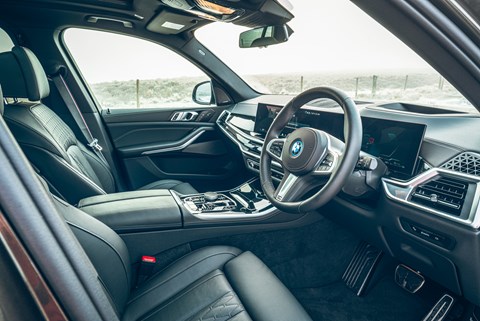
Which version is this?
There’s only one plug-in option on the X5, and that’s the 50e in M Sport trim, priced at £80,835. M Sport brings with it adaptive suspension with electronically controlled dampers. Compared to the 45e, peak power for the 50e jumps to 482bhp and e-range to 66 miles. Just bear in mind this particular X5 has over £19k of options fitted. The X5 range is also available with a choice of non-plug-in petrol and diesel engines, priced from just under £70k, all of them with 48-volt mild-hybrid assistance. A seven-seat version is available, but only with a diesel engine.
Read our BMW X5 SUV review
Pre-flight briefing: Range Rover
Why is it here?
With a battery that, at 31.8kWh, is larger than those fitted to some pure EVs, the latest Range Rover plug-in hybrid has the potential to drive more than 70 miles on a single charge using only its battery. If the Cayenne is here to interrogate the X5’s sporting ambitions, the Range Rover will be the yardstick to see just how luxurious the BMW feels.
Any clever stuff?
Standard-fit rear-wheel steering makes the Range Rover far more manoeuvrable than some of its predecessors, and there’s no boot space penalty for going PHEV – thank a battery pack slung under the floor for that. The lower belly won’t help on particularly strenuous off-road routes, although that won’t be a genuine concern for many.
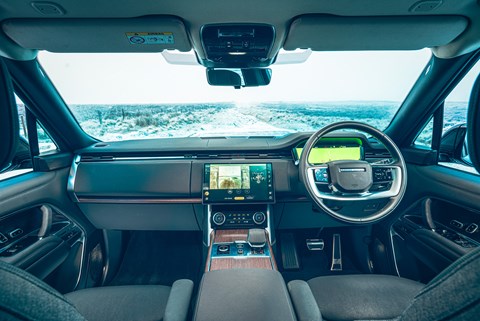
Which version is this?
The Range Rover line-up is in a transitional phase. The two plug-in hybrids, the P440e and P510e, are being replaced by upgraded versions with more potent electric motors, and new badges: P460e and P550e. The whole range is currently hybrid-only, although in most cases that means mild hybrid. Trim options are SE, HSE, Autobiography and SV, and there are standard and long versions; seven seats is an option with the latter. Not every trim level is offered with every powertrain.
Read our Range Rover review
Pre-flight briefing: Porsche Cayenne
Why is it here?
It isn’t just the X5 that’s seen a facelift, the Cayenne too has recently had a tickle to improve its performance and make it more tempting for company-car users anxiously eyeing up the tax implication of their choice. The Cayenne has always been remarkably agile for a big SUV, and now the chassis gets a tweak to sharpen the handling and improve comfort.
Any clever stuff?
The Cayenne gets a bigger-capacity battery and a higher-output electric motor, plus a new 11kW onboard charger. It has steel springs as standard, and new two-valve shocks, with separate rebound and compressions stages. The optional air suspension has adaptive dampers with a two-chamber design. Active anti-roll bars are optional.
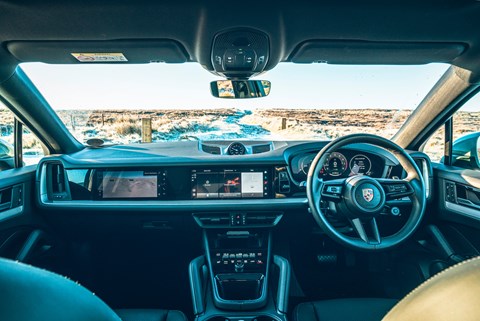
Which version is this?
Like every Porsche model, there’s a big line-up that takes some untangling. There are two bodies – Coupe, like our test car, and boxier SUV. Then there are the powertrains. Cayennes start at £70,400, but focusing only on the hybrids your choice is the 464bhp, 55-mile e-range Cayenne E-Hybrid (£79.8k for the SUV, £2100 more for the Coupe); or a 512bhp S version of the six-cylinder powertrain (from £87.1k); and the range-topping 729bhp V8 Turbo E-Hybrid starts at £130,200.
Read our Porsche Cayenne e-Hybrid review
The long game: X5 vs Range Rover vs Cayenne PHEV
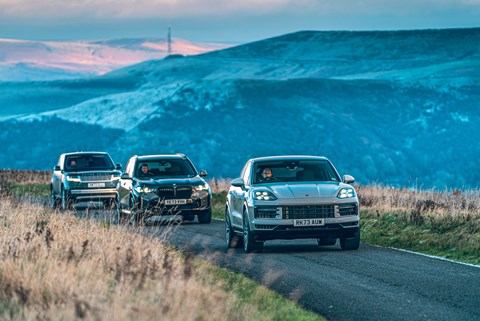
How many impossible things can I reasonably be expected to believe before breakfast? In Through the Looking Glass, the Red Queen tells Alice that she often manages six. Today I’m giving her a good run for her money as I attempt to get my head around some improbable truths. The three cars I’m driving are head-spinningly ambitious, all of them high-powered premium SUVs with plug-in hybrid powertrains aiming to be various incompatible things: luxurious, roomy, heavy, yet also agile, dynamically rewarding and, at least sometimes, clean and silent.
And the car I begin in, the refreshed Cayenne, adds to the Mad Hatter levels of implausibility by seeming to be some kind of hot hatch. I must confess that I nabbed the keys without my usual high level of pre-drive preparation, meaning I don’t actually know which of the many versions of Cayenne this is, complicated further by the many options available.
As I head to the Peak District to meet up with the rest of the team, I know it’s a regular E-Hybrid, most modest of the three PHEVs available, meaning useful if not forceful acceleration. However, pitching it into a corner at a moderate pace, I’m taken aback by the chassis’ response. This well-contained bodyroll is more akin to a GTi than a 2530kg plug-in hybrid SUV.
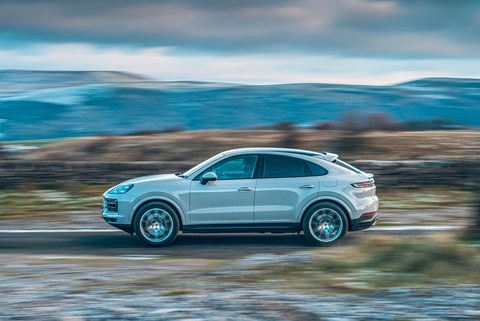
I’m convinced this must have a rogue combination of base engine and all the chassis extras, but no. A proper look at the spec sheet (and a word with Porsche to double check) shows that while the standard coils have been replaced by air and rear-steer is present, the optional active anti-roll bars are not. It turns out that’s how dynamic the Cayenne is, out of the box. Blimey.
With the Sporty member of our trio sorted, it’s time to meet Posh, the Range Rover P440e. Handling takes a back seat to comfort, and it’s very luxurious, while also offering the best e-range of the bunch, at least on paper. It is also a fair bit pricier than the Cayenne.
The reason for doing this test now is the arrival of the latest BMW X5. Our test car is a 50e, replacement for the 45e, which has been our favourite PHEV for a while thanks to its combination of e-range, luxury and driver appeal. The 50e brings a higher-capacity battery, more power, new toys and the promise of better efficiency, too.

To see if the X5 can pamper like the Range Rover, entertain like the Cayenne and deliver decent efficiency as well, we have a two-pronged test. On top of the usual exploration of dynamics, usability and comfort, we’ll find out how far each SUV will go on a fully charged battery, and how thirsty they are once the volts have subsided.
Despite their ambition to save the planet and save tax, there’s no lack of power among this trio, with peak output ranging from 434bhp in the Range Rover via 464bhp in the Cayenne to 482bhp in the X5. With the fewest horses and most weight, the Rangie can’t get close to the other two in a straight line, yet still feels more than quick enough given its size and luxury.
Both the Cayenne and X5 dip below 5.0 seconds for the 0-62mph run, although the BMW feels faster than its 0.1 second advantage would suggest. Its pace is partly down to it having a slightly pokier petrol engine, but the X5 also has the most powerful electric motor on test, at 194bhp and 207Ib ft of torque. It’s enough to surprise at the lights and get up to motorway speeds more comfortably than the other two. There will be more times in the BMW than the others when you carry out a manoeuvre purely on electric power, without the combustion engine having to fire up at all.
While the Cayenne isn’t too far behind the X5 when running on electric power, the Range Rover’s 141bhp electric motor has a hard time with 2.7 tonnes. We can’t judge too harshly, though. Order a new plug-in Range Rover now, and by the time yours is delivered the e-motor will have been boosted to 215bhp. Hopefully it’ll also get rid of the occasional slight jolt as you pull away.
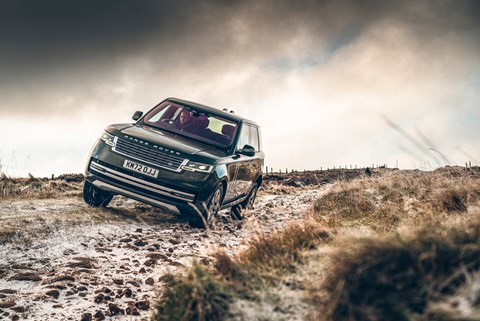
Not that you’ll really want to make use of the extra power on the twists of the Peak District. While active anti-roll bars are available, our Range Rover does without. It’s not as boaty as its predecessor and you can make good progress, but there’s far more lean than the other two, exacerbated by the high-rise driving position. Grip levels in normal conditions are behind its rivals, and the stability control works hard to ensure nothing untoward should happen. The four-wheel steering’s response is easy to judge, although it’s a system that offers the driver less feel than either of the others. However, as we meet in the Peaks there is still snow on the road, handing a decisive advantage to the Range Rover’s all-season rubber for a few hours.
The slippery conditions highlight the Cayenne’s pleasingly rear-biased four-wheel-drive system. In fact, the chassis is capable of handling far greater firepower than this basic E-Hybrid can provide. I’m not suggesting you must have the more expensive Turbo version, but I’d certainly want to test drive an S model if I were choosing between the different Cayenne PHEVs. Even so, there’s plenty of pleasure to be had. The Cayenne has the most feelsome steering on test, minimal bodyroll and a sense of agility that belies its weight.
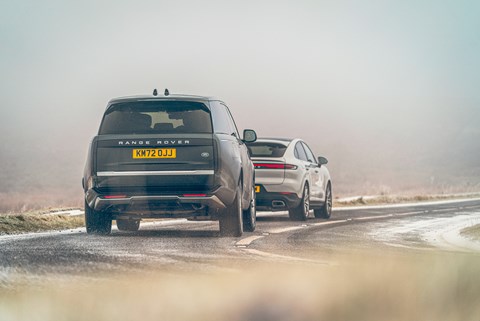
This X5 does without the optional active anti-roll bars and rear-steer; as standard it comes with air suspension and adaptive dampers. Firm springing helps keep the body upright during enthusiastic A-road blasts, and we didn’t really miss four-wheel steering. What you lose in agility you gain in a more natural feel to the drive. Similarly, the X5’s brake pedal feels nicely weighted when you give it a squeeze, avoiding the two-stage braking sensation of the Porsche. It all helps you build the confidence to switch off the stability control, letting you discover that the X5’s quite happy to shake a tail feather.
There’s an underlying firmness to both the Cayenne and X5 that’ll feel familiar to returning customers of either brand, but neither is uncomfortable. You’re undoubtedly aware of more bumps in the former, although its more consistent damping adds a layer of polish. With relatively modest 20-inch rims and big sidewalls, the Range Rover should be the one to waft. Most of the time that’s exactly what happens, as it gently floats over undulations, delivering the most cushioned ride. But when the surfaces are more hostile, it’s not so good; potholes and expansion joints can send a thud into the cabin.
Getting out of the Porsche and into the Range Rover can be quite a shock. The British car is taller and its interior much simpler than the busy Cayenne cabin. Just sitting for a moment as my seat whirs into position, the Range Rover has an immediately calming effect.
Quality is undoubtedly better than in some previous Range Rovers, and trumps the Mercedes GLS I’ve recently been in, too, although the heater dials are slightly flimsy. The infotainment system is bright, responsive and has a few handy shortcuts that make navigation easier. That said, a great many functions are controlled via the touchscreen, which can get tricky on bumpy roads.
The Range Rover isn’t alone in this, though. Where the previous X5 scored for its user-friendly interior, it’s shifted over to BMW’s newer curved display, removing the row of climate buttons and nabbing most of the space previously occupied by radio controls. While I’m sure BMW would point out the temperature is always at the bottom of the touchscreen, you now have to go into a menu to turn the heated seats and steering wheel on.
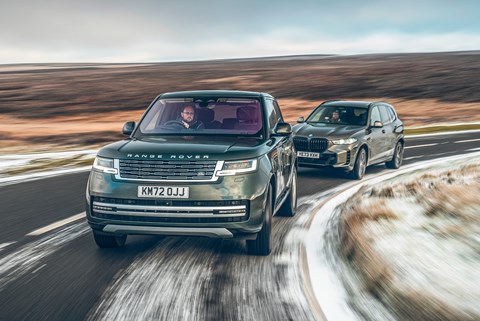
Unlike some cheaper BMWs, there’s still a physical iDrive controller between the front seats, complete with shortcut buttons. Ultimately the system involves row upon row of icons, but if you put in a bit of effort you can customise your home screen for quicker access to your most frequently used features.
And what about luxury? Well, our X5’s deep dive into the options list certainly helps it out here. The optional extra leather fitted means there’s far less plastic than the less richly spec’d Cayenne, and the Comfort Plus pack adds all the stuff you need to soothe away the potential aches and strains of long journeys. Material quality impresses, although it never quite feels as plush as the Range Rover.
Neither does the Cayenne, exacerbated by this being a rarity among Porsches in that it doesn’t have optional extra leather specified. We’ve no complaints regarding how everything is screwed together, and the plastics on display are dense and squishy for the most part. That it’s got black plastic internal door handles and standard seats without lumbar support adjustment will be a disappointment if you’re unfamiliar with basic-spec Porsches.
Thankfully this facelifted version retains physical controls for the temperature, fan speed and steering wheel. Touch-sensitive icons around them and shortcuts on the infotainment system make navigation easier. Failing that, your passenger can take over certain tasks using their own touchscreen. Overall, it’s a good compromise between usability and faddish button-count reduction.
Given its overall size, you could reasonably expect a bit more rear legroom in the Range Rover. As it is, it feels similar to the X5 but with a bit more space above your head, something the Cayenne could do with on account of the sloping roofline (but then if you were worried about that, you’d go for the SUV rather than the Coupe). The Cayenne Coupe is available as either a four-seater or a 4+1, with a small central rear seat for occasional use. (The Range Rover comes with five, but you can specify a more luxurious four-seat set-up.)

Boot space in the Cayenne is disappointing, the X5 noticeably better, with the Range Rover way out in front. Where the Porsche and BMW stick hybrid bits under the boot floor and rear seats, the Range Rover’s sits underneath the floor. In fact, take a few steps back and you’ll see the giant pack’s casing dangling beneath the line of the sills. It’s not good for breakover angles (although they’re still impressive), but it does mean boot and passenger space match any other standard-wheelbase Range Rover.
And that pack is huge for a hybrid. Getting 2.7 tonnes to do a claimed 70 miles of e-running means a battery with nearly 32kWh of usable energy. That’s more than a fully electric Mazda MX-30, and means getting the battery from empty to full on a 7kWh charger takes around five hours. Unusually for a plug-in hybrid it is capable of taking a rapid charge, still needing nearly an hour to get from empty to 80 per cent.
Both the Cayenne and X5 can take up to 11kW of AC charging current, giving a full charge in a little over two hours. A 7kW charge will take around four hours on both.
As we head back to base, all three cars have zero battery charge remaining – deliberately, so we can test how economical these cars are in circumstances that have traditionally been a major downside of PHEVs. These are big, heavy cars with big, heavy batteries, so we expect to record some fairly horrific numbers after we zero the trip meters. Past experience in previous-generation X5 and Range Rover hybrids suggest the mix of B roads, A roads and motorway should deliver a fuel economy figure in the 20s.
I needn’t have worried. Bigger batteries are able to take advantage of more potent regenerative braking to recover more energy, allowing the petrol engines to switch off more frequently. The Range Rover comes in last place on this run with 30.8mpg – not as good as the mid-thirties you’d get from a non-hybrid diesel, but certainly better than a non-hybrid petrol.
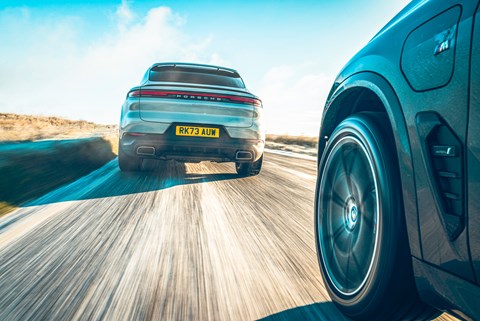
The lighter, more slippery Cayenne comes in at 32.2mpg, with the X5 topping the table with 34.8mpg. While not amazing in the grand scheme of things, these figures are certainly impressive for a 2.5-tonne lump with a 3.0-litre petrol engine, north of 400bhp and aerodynamics some way short of the best e-SUVs.
Some drivers will hope to rarely use the petrol engine, doing most of their trips on e-motor. If you have a charger at work or at home and most of your journeys are local, that’s not unrealistic. So perhaps the more important question is how far will they go in electric mode? As it’s freezing and all need a charge, I leave the three SUVs plugged in overnight at the office and return the next day ready to lap the Peterborough area – a lap that mixes suburban 30 and 40mph limits, a bit of A-road, and a stretch on the A1 – until they’re empty.
With the mercury sitting at 2ºC the following morning, when I turn on the Cayenne I see it has accounted for the temperature drop and is predicting a range some way off the official figures; I check, and the others have done likewise. While the Porsche’s official e-range is 55 miles, today the in-car read-out predicts 42. That’s fair enough as it’ll be hard work getting the cabin up to 20º, and I’m not doing without a heated seat on this test. I’ll be using the same settings in all three cars, to level the playing field.

The Cayenne gives up part way through the second lap of our loop after 32.7 miles. The good news is that it’s still more than enough for the average daily commute, the bad is that it’s over 20 miles down on the official figures. Clambering up into the Range Rover, the official 69-mile range has been reduced to a predicted 54; in reality it’s at 44.2 miles that I hear the engine fire.
With the second smallest battery on test, I’m expecting a short drive in the BMW. But no. The driver’s display promises 52 miles, against an official figure of 66 miles. The trip computer proves to be far more accurate than the others. It’s not until the trip ticks over to 48.8 miles that I see the revcounter’s needle flicker into action.
For every kWh you’ll only travel 1.4 miles in the Range Rover. The Cayenne is barely better at 1.5 miles per kWh. The X5 is far superior at 1.9 miles per kWh. In comparison, an average EV will get around 3.0 miles per kWh, an efficient one 4.0 miles per kWh and an exceptional one 5.0 miles per kWh. That’s the penalty for dragging around a heavy combustion engine everywhere.
X5 vs Range Rover vs Cayenne PHEV: the final reckoning
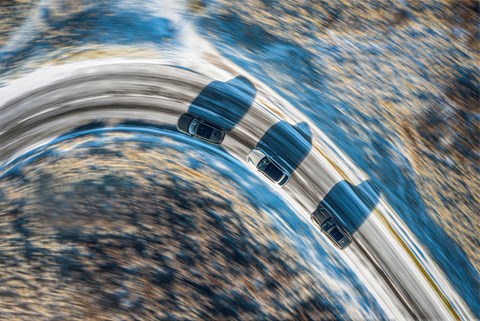
The big plug-in hybrid SUV has come a long way in five years. Back then a real-world electric range of less than 20 miles wasn’t unheard of, and a diesel would annihilate it for economy when the battery emptied. Now, all these contenders have decent economy whether you’re using just electric, just engine or both.
Transitions between e-motor and engine occur smoothly and swiftly, and the increase in range hasn’t come at the expense of cabin space. Real progress.
You could argue a compelling case for any one of these cars, but in this test we’re particularly focused on their qualities as plug-in hybrids, which makes it easier to pick a winner.
Its PHEV figures are just enough to tip the Cayenne into last place. Yes, it performed slightly better than the Range Rover for efficiency, but the electric range is the smallest here. That said, it’s a wonderful car, with great handling, and its bulk disappears except under heavy braking. Would the more powerful S E-Hybrid version have finished higher? Maybe.
Narrowly beating it is the Range Rover, despite having the biggest thirst for both petrol and volts. It possesses all the Range Rover attributes we already know and love. It’s far pricier than the others, but it’s money well spent if you want a luxury vehicle with high levels of comfort and class. The powertrain in this test car will soon be replaced; we expect great things from the updated P460e and P550e.
However, it’s the X5 50e that wins this test, picking up where the 45e left off. Yes, this one is fitted with an awful lot of options, yet it still undercuts this Range Rover by £30k despite having so much equipment. Does it feel as luxurious? No, but it’s certainly not as far away as that price gap would have you believe. It’s not far off the fun provided by the Cayenne, either.
And then there’s the hybrid bit to consider. We know BMW’s six-cylinder engines are uncannily efficient, and it seems to sprinkle the same special sauce on its batteries and electric motors. The X5 really is an astonishingly effective PHEV.
On top of having the longest range and best electric efficiency of these cars, it’s also the most frugal when being driven with an uncharged battery, and feels the punchiest in electric-only mode. It satisfies both head and heart, and is head and shoulders above the other two, even though both are very good, and much improved on previous generations of SUV PHEVs.
X5 vs Range Rover vs Cayenne PHEV: the verdict
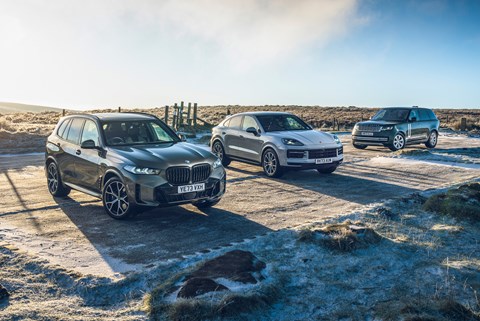
First place
BMW X5
All-round brilliance that’s hard to fault
Second place
Range Rover
Relatively thirsty, but gloriously luxurious and capable
Third place
Porsche Cayenne
A great chassis tarnished by a slightly lacklustre powertrain and brakes